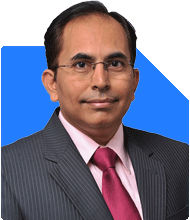Janak Patel |71 Answers |Ask -Follow
MF, PF Expert - Answered on May 24, 2025
He is the CEO and founder of InfiniumWealth, a firm that specialises in designing goal-specific financial plans tailored to help clients achieve their life goals.
Janak holds an MBA degree in finance from the Welingkar Institute of Management Development and Research, Mumbai, and has over 15 years of experience in the field of personal finance. ... more

sir, i am 39 YO, single mother working in Oman. since i reside outside india i cannot open a demat account. i am currently investing in SBI mutual funds ( since i have my NRE account in SBI). i have invested 25 lakhs 15 lakhs in Multi cap fund 4 lakhs in Gold fund 5 lakhs in SBI magnum child benefit fund 1 lakh in Long term equity fund ELSS and 50,000 in SBI bluchip. i have child education policy where i pay 2.5 lakhs or 5 years and leave it for 5 years and my child is eligible of 25 lakhs. i already paid 2 installments and for next 3 installments, i have taken 3 funds- SBI savings fund for 1 year, SBI liquid Fund for 2 years and SBI balanced advance fund for 3 years. i want to pay the remaining 3 installments with this three funds accordingly. Please advice if i can improve my financial investment journey. thank you.
I believe the banking relationship with SBI has led you to invest in various schemes of SBI Mutual Fund.
For the child's education, you have already committed to a plan and invested in various schemes to supplement it. That's fine.
As for the other schemes you have invested 25 lakhs - they are all also SBI schemes. When you invest across various schemes of one Mutual Fund house, you end up not optimizing your investments and thus add risk towards your investment's potential.
Not all schemes from a fund house perform above expectations and hence it's good to diversify across fund houses too.
Especially when you are looking to create wealth over a long time period.
For example the SBI Multicap is not above it category average over last 3 years period (its only 3 years old). I would suggest to change this investment to either Nippon Multicap or Mahindra Manulife Multicap schemes.
Currently you are heavy on Large cap and though its stable and good option, you should decide your long term investment goal.
Accordingly going forward for new investments do consider funds that will complement your investment requirement. If you have long term plan in mind, say more than 10 years, you can consider a mid-cap or even a small cap scheme to diversify and aim for higher growth (with a little added risk) towards wealth creation.
On your next visit to India, or if comfortable online/on call, you can consult a CFP/Financial advisor to discuss and prepare a plan towards achieving your goals. A fee based service with them, which aims to optimize your interests/goals will add a lot more value for you rather then someone who wants to sell their products to you.
Thanks & Regards
Janak Patel
Certified Financial Planner.
You may like to see similar questions and answers below
Ramalingam Kalirajan |10870 Answers |Ask -Follow
Mutual Funds, Financial Planning Expert - Answered on May 03, 2024
Ramalingam Kalirajan |10870 Answers |Ask -Follow
Mutual Funds, Financial Planning Expert - Answered on Jul 02, 2024
Ramalingam Kalirajan |10870 Answers |Ask -Follow
Mutual Funds, Financial Planning Expert - Answered on Oct 14, 2024
Ramalingam Kalirajan |10870 Answers |Ask -Follow
Mutual Funds, Financial Planning Expert - Answered on Jun 21, 2025
Ulhas Joshi |280 Answers |Ask -Follow
Mutual Fund Expert - Answered on Dec 05, 2025
Dr Dipankar Dutta |1835 Answers |Ask -Follow
Tech Careers and Skill Development Expert - Answered on Dec 04, 2025
Ravi Mittal |676 Answers |Ask -Follow
Dating, Relationships Expert - Answered on Dec 04, 2025
Anu Krishna |1745 Answers |Ask -Follow
Relationships Expert, Mind Coach - Answered on Dec 04, 2025
Anu Krishna |1745 Answers |Ask -Follow
Relationships Expert, Mind Coach - Answered on Dec 04, 2025
Mayank Chandel |2562 Answers |Ask -Follow
IIT-JEE, NEET-UG, SAT, CLAT, CA, CS Exam Expert - Answered on Dec 04, 2025
Mayank Chandel |2562 Answers |Ask -Follow
IIT-JEE, NEET-UG, SAT, CLAT, CA, CS Exam Expert - Answered on Dec 04, 2025
Mayank Chandel |2562 Answers |Ask -Follow
IIT-JEE, NEET-UG, SAT, CLAT, CA, CS Exam Expert - Answered on Dec 04, 2025
Mayank Chandel |2562 Answers |Ask -Follow
IIT-JEE, NEET-UG, SAT, CLAT, CA, CS Exam Expert - Answered on Dec 04, 2025
Mayank Chandel |2562 Answers |Ask -Follow
IIT-JEE, NEET-UG, SAT, CLAT, CA, CS Exam Expert - Answered on Dec 04, 2025

























